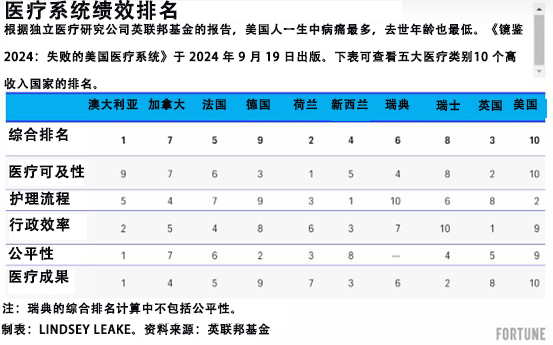
針對(duì)10個(gè)高收入國(guó)家醫(yī)療系統(tǒng)績(jī)效的一項(xiàng)新分析顯示,美國(guó)的醫(yī)療系統(tǒng)最特別,,可惜是特別糟糕,。
根據(jù)獨(dú)立醫(yī)療研究公司英聯(lián)邦基金(Commonwealth Fund)的報(bào)告,美國(guó)人一生中病痛最多,,去世年齡也最低,?!剁R鑒2024:失敗的美國(guó)醫(yī)療系統(tǒng)》(Mirror 2024: A Portrait of the Failing U.S. Health System)已于9月19日出版。
除了總體排名最差之外,,五大類別中有三個(gè)類別美國(guó)(公平性,、醫(yī)療成果和醫(yī)療可及性)排名最后。行政效率方面美國(guó)表現(xiàn)稍好,,排名第九,,領(lǐng)先瑞士。但醫(yī)療支出超過(guò)了參與評(píng)估的其他國(guó)家,。
“在保護(hù)人民健康和福利方面,,美國(guó)沒(méi)盡到作為國(guó)家的主要義務(wù),”英聯(lián)邦基金主席約瑟夫·貝坦科爾特在一份準(zhǔn)備好的聲明中表示,,“醫(yī)療資金支出最多,,效果卻最差,如此現(xiàn)狀不可持續(xù),。關(guān)鍵不在于缺乏資源,,而是資源利用的方式?!?/p>
美國(guó)只在護(hù)理流程類別中表現(xiàn)出色,,主要涉及安全、預(yù)防,、協(xié)調(diào)和患者參與等,。報(bào)告稱,美國(guó)之所以能排第二,,“主要因?yàn)槌晒μ峁╊A(yù)防服務(wù),,如乳房X光檢查和流感疫苗接種,對(duì)患者安全也足夠重視,?!?/p>
《鏡鑒》報(bào)告使用的數(shù)據(jù)為2021年到2023年收集,70個(gè)指標(biāo)涵蓋五個(gè)類別,。英聯(lián)邦基金國(guó)際衛(wèi)生政策調(diào)查的受訪者包括基層醫(yī)生,,年齡大于18歲的普通人群以及65歲及以上人群。其他數(shù)據(jù)來(lái)源包括世界衛(wèi)生組織(World Health Organization)和經(jīng)濟(jì)合作與發(fā)展組織(Organization for Economic Cooperation and Development),。
以下是各國(guó)2024年與2021年上一份報(bào)告相比情況,。三年前排名第一的挪威退出了國(guó)際衛(wèi)生政策調(diào)查,因此未參與今年排名,。
醫(yī)療系統(tǒng)最佳的高收入國(guó)家
1.澳大利亞(上次排名第3位)
2.荷蘭(同上次)
3.英國(guó)(上次排名第4位)
4.新西蘭(上次排名第6位)
5.法國(guó)(上次排名第8位)
醫(yī)療系統(tǒng)最差的高收入國(guó)家
6.瑞典(上次排名第7位)
7.加拿大(上次排名第10位)
8.瑞士(上次排名第9位)
9.德國(guó)(上次排名第5位)
10.美國(guó)(上次排名第11位,,雖進(jìn)步一位但仍排最末)
報(bào)告指出,多數(shù)國(guó)家之間整體表現(xiàn)差異相對(duì)較小,但美國(guó)是唯一表現(xiàn)“明顯較差”的國(guó)家,。
醫(yī)療領(lǐng)域其他排名
·醫(yī)療可及性最佳:荷蘭(同上次)
·醫(yī)療可及性最差:美國(guó)(同上次)
·行政效率最高:英國(guó)(上次為挪威)
·行政效率最差:瑞士(上次為美國(guó))
·護(hù)理流程最佳:新西蘭(同上次)
·護(hù)理流程最差:瑞典(同上次)
·公平性最佳:澳大利亞(同上次)
·公平性最差:美國(guó)(同上次)
·醫(yī)療成果最佳:澳大利亞(同上次)
·醫(yī)療成果最差:美國(guó)(同上次)
“《鏡鑒》報(bào)告強(qiáng)調(diào)國(guó)際比較的重要性,,可為改善美國(guó)衛(wèi)生系統(tǒng)提供證據(jù)和啟發(fā),”英聯(lián)邦基金負(fù)責(zé)國(guó)際衛(wèi)生政策和實(shí)踐創(chuàng)新的副總裁雷金納德·威廉姆斯在一份準(zhǔn)備好的聲明中表示,,“其他國(guó)家已成功滿足國(guó)民的健康需求,,美國(guó)的衛(wèi)生系統(tǒng)卻仍然嚴(yán)重落后?!?/p>
“報(bào)告顯示,,采取有效的戰(zhàn)略以及明智的投資可以加強(qiáng)美國(guó)醫(yī)療系統(tǒng),從而更好地滿足國(guó)民需求,。如果能切實(shí)做到,,美國(guó)的地位就能提升?!?/p>

美國(guó)醫(yī)療支出有多少,?
美國(guó)醫(yī)療支出相對(duì)較高并不是什么新鮮事,然而美國(guó)與其他九個(gè)國(guó)家醫(yī)療支出的差距已形成巨大鴻溝,。
從1980年開(kāi)始,,美國(guó)醫(yī)療支出占國(guó)內(nèi)生產(chǎn)總值(GDP)的8.2%;英國(guó)支出最低,,為5.1%,。到2020年,美國(guó)支出已攀升至18.6%,。2022年比例降至16.5%,,其他九個(gè)國(guó)家的醫(yī)療支出則介于9.8%(澳大利亞)和12.6%(德國(guó))。
報(bào)告凸顯了具有諷刺意味的事實(shí),,即美國(guó)在醫(yī)療領(lǐng)域支出最多卻表現(xiàn)最差,。此外,醫(yī)療最好的兩個(gè)國(guó)家,,澳大利亞和荷蘭反而支出最少,。
美國(guó)醫(yī)療改革并非毫無(wú)希望
今年是大選之年,醫(yī)療改革是美國(guó)兩黨選民最關(guān)心的問(wèn)題,,《鏡鑒》報(bào)告也尖銳反映了美國(guó)的問(wèn)題,。
美國(guó)醫(yī)療保險(xiǎn)覆蓋相當(dāng)割裂,2600萬(wàn)美國(guó)人沒(méi)有保險(xiǎn),,其他九個(gè)國(guó)家都實(shí)現(xiàn)了全民覆蓋,。對(duì)很多美國(guó)人來(lái)說(shuō),處理醫(yī)療賬單就是噩夢(mèng),,英國(guó)和澳大利亞則將賬單負(fù)擔(dān)降至最低,。在各年齡段中,美國(guó)可預(yù)防和可治療的死亡率均為最高,。預(yù)計(jì)美國(guó)人壽命將比10個(gè)國(guó)家平均水平少4年以上,,原因很大程度上是槍支暴力和藥物濫用。
原因還有很多,。盡管如此,,聯(lián)邦基金的研究人員認(rèn)為,研究結(jié)果并非不可逾越的障礙,,而是值得學(xué)習(xí)的時(shí)刻,。在關(guān)于該報(bào)告的新聞稿中,研究人員建議采取一些政策舉措,,包括:
·將醫(yī)療保健覆蓋范圍擴(kuò)大到未參保人群,,改革保險(xiǎn)覆蓋范圍以達(dá)到最起碼的適當(dāng)標(biāo)準(zhǔn),包括限制患者的自付費(fèi)用,,讓醫(yī)療更實(shí)惠也更方便,。
·消除低收入個(gè)人、非裔,、拉丁裔和原住民,、女性和農(nóng)村居民在健康和醫(yī)療服務(wù)方面的差距,改善健康公平,。相關(guān)弱勢(shì)人群經(jīng)常面臨歧視,,享受的醫(yī)療質(zhì)量較低。
“由于醫(yī)療系統(tǒng)失敗,,太多美國(guó)人壽命短且病痛多,,”貝坦科爾特說(shuō),“我們要建立價(jià)格低廉,,人人都能受益的醫(yī)療系統(tǒng)?,F(xiàn)在就是迎接這一挑戰(zhàn)的時(shí)候?!保ㄘ?cái)富中文網(wǎng))
譯者:梁宇
審校:夏林
針對(duì)10個(gè)高收入國(guó)家醫(yī)療系統(tǒng)績(jī)效的一項(xiàng)新分析顯示,,美國(guó)的醫(yī)療系統(tǒng)最特別,可惜是特別糟糕,。
根據(jù)獨(dú)立醫(yī)療研究公司英聯(lián)邦基金(Commonwealth Fund)的報(bào)告,,美國(guó)人一生中病痛最多,去世年齡也最低,?!剁R鑒2024:失敗的美國(guó)醫(yī)療系統(tǒng)》(Mirror 2024: A Portrait of the Failing U.S. Health System)已于9月19日出版。
除了總體排名最差之外,,五大類別中有三個(gè)類別美國(guó)(公平性,、醫(yī)療成果和醫(yī)療可及性)排名最后,。行政效率方面美國(guó)表現(xiàn)稍好,排名第九,,領(lǐng)先瑞士,。但醫(yī)療支出超過(guò)了參與評(píng)估的其他國(guó)家。
“在保護(hù)人民健康和福利方面,,美國(guó)沒(méi)盡到作為國(guó)家的主要義務(wù),,”英聯(lián)邦基金主席約瑟夫·貝坦科爾特在一份準(zhǔn)備好的聲明中表示,“醫(yī)療資金支出最多,,效果卻最差,,如此現(xiàn)狀不可持續(xù)。關(guān)鍵不在于缺乏資源,,而是資源利用的方式,。”
美國(guó)只在護(hù)理流程類別中表現(xiàn)出色,,主要涉及安全,、預(yù)防、協(xié)調(diào)和患者參與等,。報(bào)告稱,,美國(guó)之所以能排第二,“主要因?yàn)槌晒μ峁╊A(yù)防服務(wù),,如乳房X光檢查和流感疫苗接種,,對(duì)患者安全也足夠重視?!?/p>
《鏡鑒》報(bào)告使用的數(shù)據(jù)為2021年到2023年收集,,70個(gè)指標(biāo)涵蓋五個(gè)類別。英聯(lián)邦基金國(guó)際衛(wèi)生政策調(diào)查的受訪者包括基層醫(yī)生,,年齡大于18歲的普通人群以及65歲及以上人群,。其他數(shù)據(jù)來(lái)源包括世界衛(wèi)生組織(World Health Organization)和經(jīng)濟(jì)合作與發(fā)展組織(Organization for Economic Cooperation and Development)。
以下是各國(guó)2024年與2021年上一份報(bào)告相比情況,。三年前排名第一的挪威退出了國(guó)際衛(wèi)生政策調(diào)查,,因此未參與今年排名。
醫(yī)療系統(tǒng)最佳的高收入國(guó)家
1.澳大利亞(上次排名第3位)
2.荷蘭(同上次)
3.英國(guó)(上次排名第4位)
4.新西蘭(上次排名第6位)
5.法國(guó)(上次排名第8位)
醫(yī)療系統(tǒng)最差的高收入國(guó)家
6.瑞典(上次排名第7位)
7.加拿大(上次排名第10位)
8.瑞士(上次排名第9位)
9.德國(guó)(上次排名第5位)
10.美國(guó)(上次排名第11位,,雖進(jìn)步一位但仍排最末)
報(bào)告指出,,多數(shù)國(guó)家之間整體表現(xiàn)差異相對(duì)較小,但美國(guó)是唯一表現(xiàn)“明顯較差”的國(guó)家,。
醫(yī)療領(lǐng)域其他排名
·醫(yī)療可及性最佳:荷蘭(同上次)
·醫(yī)療可及性最差:美國(guó)(同上次)
·行政效率最高:英國(guó)(上次為挪威)
·行政效率最差:瑞士(上次為美國(guó))
·護(hù)理流程最佳:新西蘭(同上次)
·護(hù)理流程最差:瑞典(同上次)
·公平性最佳:澳大利亞(同上次)
·公平性最差:美國(guó)(同上次)
·醫(yī)療成果最佳:澳大利亞(同上次)
·醫(yī)療成果最差:美國(guó)(同上次)
“《鏡鑒》報(bào)告強(qiáng)調(diào)國(guó)際比較的重要性,,可為改善美國(guó)衛(wèi)生系統(tǒng)提供證據(jù)和啟發(fā),”英聯(lián)邦基金負(fù)責(zé)國(guó)際衛(wèi)生政策和實(shí)踐創(chuàng)新的副總裁雷金納德·威廉姆斯在一份準(zhǔn)備好的聲明中表示,,“其他國(guó)家已成功滿足國(guó)民的健康需求,,美國(guó)的衛(wèi)生系統(tǒng)卻仍然嚴(yán)重落后,。”
“報(bào)告顯示,,采取有效的戰(zhàn)略以及明智的投資可以加強(qiáng)美國(guó)醫(yī)療系統(tǒng),,從而更好地滿足國(guó)民需求。如果能切實(shí)做到,,美國(guó)的地位就能提升?!?/p>
醫(yī)療系統(tǒng)績(jī)效排名
根據(jù)獨(dú)立醫(yī)療研究公司英聯(lián)邦基金的報(bào)告,,美國(guó)人一生中病痛最多,去世年齡也最低,?!剁R鑒2024:失敗的美國(guó)醫(yī)療系統(tǒng)》于 2024 年 9 月 19 日出版。下表可查看五大醫(yī)療類別10 個(gè)高收入國(guó)家的排名,。
澳大利亞 加拿大 法國(guó) 德國(guó) 荷蘭 新西蘭 瑞典 瑞士 英國(guó) 美國(guó)
綜合排名
醫(yī)療可及性
護(hù)理流程
行政效率
公平性
醫(yī)療成果
注:瑞典的綜合排名計(jì)算中不包括公平性,。
制表:Lindsey Leake。資料來(lái)源:英聯(lián)邦基金
美國(guó)醫(yī)療支出有多少,?
美國(guó)醫(yī)療支出相對(duì)較高并不是什么新鮮事,,然而美國(guó)與其他九個(gè)國(guó)家醫(yī)療支出的差距已形成巨大鴻溝。
從1980年開(kāi)始,,美國(guó)醫(yī)療支出占國(guó)內(nèi)生產(chǎn)總值(GDP)的8.2%,;英國(guó)支出最低,為5.1%,。到2020年,,美國(guó)支出已攀升至18.6%。2022年比例降至16.5%,,其他九個(gè)國(guó)家的醫(yī)療支出則介于9.8%(澳大利亞)和12.6%(德國(guó)),。
報(bào)告凸顯了具有諷刺意味的事實(shí),即美國(guó)在醫(yī)療領(lǐng)域支出最多卻表現(xiàn)最差,。此外,,醫(yī)療最好的兩個(gè)國(guó)家,澳大利亞和荷蘭反而支出最少,。
美國(guó)醫(yī)療改革并非毫無(wú)希望
今年是大選之年,,醫(yī)療改革是美國(guó)兩黨選民最關(guān)心的問(wèn)題,《鏡鑒》報(bào)告也尖銳反映了美國(guó)的問(wèn)題,。
美國(guó)醫(yī)療保險(xiǎn)覆蓋相當(dāng)割裂,,2600萬(wàn)美國(guó)人沒(méi)有保險(xiǎn),其他九個(gè)國(guó)家都實(shí)現(xiàn)了全民覆蓋,。對(duì)很多美國(guó)人來(lái)說(shuō),,處理醫(yī)療賬單就是噩夢(mèng),,英國(guó)和澳大利亞則將賬單負(fù)擔(dān)降至最低。在各年齡段中,,美國(guó)可預(yù)防和可治療的死亡率均為最高,。預(yù)計(jì)美國(guó)人壽命將比10個(gè)國(guó)家平均水平少4年以上,原因很大程度上是槍支暴力和藥物濫用,。
原因還有很多,。盡管如此,聯(lián)邦基金的研究人員認(rèn)為,,研究結(jié)果并非不可逾越的障礙,,而是值得學(xué)習(xí)的時(shí)刻。在關(guān)于該報(bào)告的新聞稿中,,研究人員建議采取一些政策舉措,,包括:
·將醫(yī)療保健覆蓋范圍擴(kuò)大到未參保人群,改革保險(xiǎn)覆蓋范圍以達(dá)到最起碼的適當(dāng)標(biāo)準(zhǔn),,包括限制患者的自付費(fèi)用,,讓醫(yī)療更實(shí)惠也更方便。
·消除低收入個(gè)人,、非裔,、拉丁裔和原住民、女性和農(nóng)村居民在健康和醫(yī)療服務(wù)方面的差距,,改善健康公平,。相關(guān)弱勢(shì)人群經(jīng)常面臨歧視,享受的醫(yī)療質(zhì)量較低,。
“由于醫(yī)療系統(tǒng)失敗,,太多美國(guó)人壽命短且病痛多,”貝坦科爾特說(shuō),,“我們要建立價(jià)格低廉,,人人都能受益的醫(yī)療系統(tǒng)。現(xiàn)在就是迎接這一挑戰(zhàn)的時(shí)候,?!保ㄘ?cái)富中文網(wǎng))
譯者:梁宇
審校:夏林
The U.S. health care system is in a class all its own, according to a new analysis of health system performance in 10 high-income countries—but in a devastating way.
Americans live the sickest lives and die the youngest, per a report by the Commonwealth Fund, an independent health care research firm. Mirror, Mirror 2024: A Portrait of the Failing U.S. Health System was published Thursday.
The U.S. came in last in three of five categories—equity, health outcomes, and access to care—in addition to having the poorest overall ranking. The country performed slightly better in administrative efficiency, finishing ninth ahead of Switzerland. This, despite spending more than any other nation included in the assessment.
“The U.S. is failing one of its principal obligations as a nation: to protect the health and welfare of its people,” Dr. Joseph Betancourt, president of the Commonwealth Fund, said in a prepared statement. “The status quo—continually spending the most and getting the least for our health care dollars—is not sustainable. It isn’t about lack of resources—it’s clearly about how they are being spent.”
The U.S. excelled only in a category called care process, which considers safety, prevention, coordination, and patient engagement. Its second-place finish, the report said, “is the result of the successful provision of preventive services, such as mammograms and flu vaccinations, and an emphasis on patient safety.”
Mirror, Mirror used data collected from 2021 through 2023, with 70 metrics spanning the five categories. Commonwealth Fund International Health Policy Survey respondents included primary care physicians, the general population of adults aged 18 and older, and a subset of those 65 and older. Additional data sources included the World Health Organization and the Organization for Economic Cooperation and Development.
Below are each country’s 2024 ranking, compared to the previous 2021 report. Norway, which took the top spot three years ago, exited the International Health Policy Survey and isn’t included in this year’s rankings.
High-income countries with best health care systems
1. Australia (up from No. 3)
2. Netherlands (same)
3. U.K. (up from No. 4)
4. New Zealand (up from No. 6)
5. France (up from No. 8)
High-income countries with worst health care systems
6. Sweden (up from No. 7)
7. Canada (up from No. 10)
8. Switzerland (up from No. 9)
9. Germany (down from No. 5)
10. U.S. (technically up from No. 11 but still last place)
While differences in overall performance between most countries were relatively small, the report noted, the U.S. was the sole outlier with “dramatically lower” performance.
Other health care rankings
·Best access to care: Netherlands (same)
·Worst access to care: U.S. (same)
·Best administrative efficiency: U.K. (was Norway)
·Worst administrative efficiency: Switzerland (was U.S.)
·Best care process: New Zealand (same)
·Worst care process: Sweden (same)
·Best equity: Australia (same)
·Worst equity: U.S. (same)
·Best health outcomes: Australia (same)
·Worst health outcomes: U.S. (same)
“Mirror, Mirror underscores the importance of international comparisons, offering evidence and inspiration to improve America’s health system,” Reginald Williams, Commonwealth Fund vice president of international health policy and practice innovations, said in a prepared statement. “While other nations have successfully met their populations’ health needs, the U.S. health system continues to lag significantly.
“This report shows that by adopting proven strategies and making smart investments, America can enhance its health system to better meet the needs of its people. There’s no reason we can’t elevate our standing if we choose to do so.”
HEALTH CARE SYSTEM PERFORMANCE RANKINGS
Americans live the sickest lives and die the youngest, per a report by the Commonwealth Fund, anindependent health care research firm. Mirror, Mirror 2024: A Portrait of the Failing U.S. Health System waspublished Sept. 19, 2024. Scroll through the table below to see how 10 high-income countries rank in fivehealth care categories.
AUS CAN FRA GER NETH NZ SWE SWIZ U.K U.S.
OVERALL RANKING
ACCESS TO CARE
CARE PROCESS
ADMINISTRATIVE EFFICIENCY
EQUITY
HEALTH OUTCOMES
NOTE: EQUITY NOT INCLUDED IN SWEDEN'S OVERALL RANKING CALCULATION.
TABLE: LINDSEY LEAKE·SOURCE: COMMONWEALTHFUND
How much is the U.S. spending on health care?
The nation’s relatively high health care spending isn’t new, but the gap between U.S. expenditures and those of the nine other ranked countries has widened to a chasm.
Beginning in 1980, U.S. health care spending was 8.2% of its gross domestic product (GDP); the U.K. had the lowest spending at 5.1%. By 2020, U.S. spending had climbed to a high of 18.6%. That dipped to 16.5% in 2022, when spending of the other nine countries was between 9.8% (Australia) and 12.6% (Germany).
The report highlights the irony that the country that spent the most on health care, the U.S., performed the poorest. What’s more, the two countries that performed the best, Australia and the Netherlands, spent the least.
Hope not lost for U.S. health care reform
In this presidential election year, health care reform is top of mind for American voters on both sides of the political aisle, and Mirror, Mirror paints the nation’s problems in striking contrast.
Health insurance coverage in the U.S. is fragmented—leaving 26 million Americans uninsured—while the other nine countries boast universal coverage. Navigating medical bills is a nightmare for many Americans, yet the U.K. and Australia minimize billing burdens. The U.S. has the highest rates of preventable and treatable deaths among all ages. Americans are projected to live more than four fewer years than the 10-country average, in no small part due to gun violence and substance abuse.
The list goes on. Still, Commonwealth Fund researchers concluded their findings presented more a teachable moment than an insurmountable obstacle. In a news release about the report, they recommended a number of policy initiatives, including:
·Make health care more affordable and more accessible by extending health care coverage to the remaining uninsured and reforming insurance coverage to meet minimal standards of adequacy, including limits on patients’ out-of-pocket expenses.
·Improve health equity by eliminating disparities in the health and health care delivery that low-income individuals, Black, Latino, and Indigenous people, women, and people who live in rural areas receive. These populations often face discrimination and receive lower-quality care.
“Too many Americans are living shorter, sicker lives because of this failure,” Betancourt said. “We need to build a health system that is affordable and that works for everyone. It’s past time that we step up to this challenge.”






